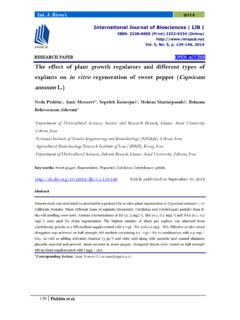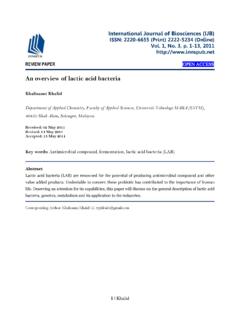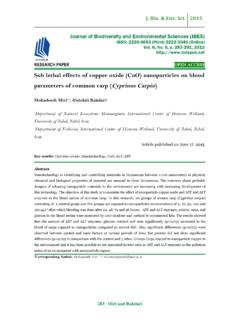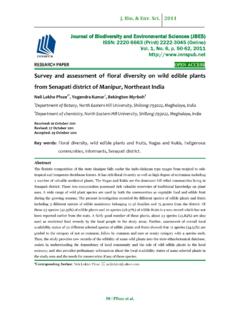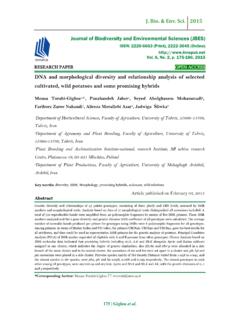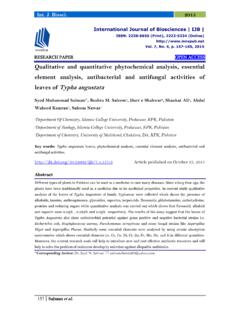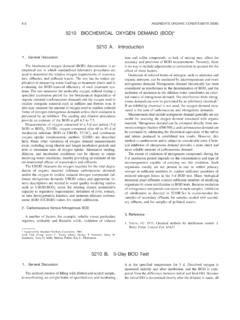Transcription of Effect of salicylic acid on alleviation of salt stress on ...
1 20 Mohammadi et al. Int. J. Biosci. 2013 RESEARCH PAPER OPEN ACCESS Effect of salicylic acid on alleviation of salt stress on growth and some physiological traits of wheat Mohammadi Morad1*, Safikhani Sara2, Dashtaki Mohammad2, Rajabi Mohammad Javad2, Ranjbar Majid2 1 Department of Plant Eco-physiology, Faculty of Agriculture, University of Tabriz, Iran 2 Department of Agronomy and Plant breeding, Tehran University, Faculty of Agriculture, Karaj branch, Karaj, Iran Key words: Chlorophyll content, proline, relative water content, salicylic acid, salt stress , spike, wheat. doi: Article published on February 25, 2013 Abstract To evaluate the Effect of salt stress and salicylic acid application on growth and yield component traits of wheat, an experiment was conducted in factorial based on RCBD design with 3 replications in research farm (green house condition) of University of Tehran (Karaj-Iran) during 2010-11.
2 Salt stress factor including three levels (control, salt stress with Nacl 4 ds/m and Nacl 8 ds/m) and acid salicylic (application and none application). The experiment was carried out on two variety of wheat, separately. The results indicated that maximum height was achieved in control SA none application treatment and minimum height was achieved in Nacl8 ds/m SA none application treatment. Also SA application increased number of grain in spike. SA application alleviated destructive Effect of salt stress . The results indicated that interaction Effect of salt stress SA had significant Effect (p ) on Tabasi variety but had not significant Effect on Arvand variety on total chlorophyll and relative water content traits. It can be concluded that foliar application of wheat cultivar plants with salicylic acid stimulate the growth of wheat plants via the enhancement of the biosynthesis of photosynthetic pigments; improved relative water content, decreasing of organic solutes (proline) and thus salicylic acid treatment improved wheat growth especially on Tabasi variety.
3 * Corresponding Author: Mohammadi Morad International Journal of Biosciences | IJB | ISSN: 2220-6655 (Print) 2222-5234 (Online) Vol. 3, No. 2, p. 20-27, 2013 21 Mohammadi et al. Int. J. Biosci. 2013 Introduction Wheat (Triticum aestivum L.) is the major cereal crop of Iran, which is grown all over the country. Per hectare yield of wheat is far below than its yield potential, which may be due to different reasons such as drought, nutrient managements, and salinity. The restriction of wheat growth and productivity due to salinity is especially acute in arid and semiarid regions of Iran. Salinity is a major environmental stress that adversely affects plant growth and metabolism. Salinity impact on plants in two main ways: osmotic stress and ion toxicity (Munns, 2005). Osmotic stress is caused by ions (mainly Na+ and Cl-) in the soil solution decreasing the availability of water to roots.
4 Ion toxicity occur when plant roots take up Na+ and/or Cl- and these ions accumulated to detrimental levels in leaves. Ion imbalances and nutrient deficiency, particularly for K+ nutrition, can be also occur (Tejera et al. 2007). Under these conditions, plants have adopted mechanisms to attenuate and/or tolerate osmotic and ionic stresses. These mechanisms include osmotic adjustment by accumulation of compatible inorganic as well as organic solutes, the production of stress proteins (Sairam and Tyagi, 2004). Proline accumulation in salt stressed plants is a primary defense response to maintain the osmotic pressure in a cell. The role of proline in cell osmotic adjustment, membrane stabilization and detoxification of injurious ions in plants exposed to salt stress (Ashraf and Foolad, 2007).
5 salicylic acid (SA) is accumulated in the plant tissues under the impact of unfavorable abiotic factors, contributing to the increase of plants resistance to salinization (Ding et al. 2002; Kang and Saltveit, 2002). In addition, SA-induced increase in the resistance of wheat seedlings to salinity (Shakirova and Bezrukova, 1997). Thus the detrimental effects of high salts on the early growth of wheat seedlings may be alleviated by treating seeds with the proper concentration of a suitable hormone (Darra et al. 1973). Gutierrez Coronado et al. (1998) observed significant Effect of SA on soybean increases in shoots growth , root growth and plant height. Khodary (2004) reported that SA increased the fresh and dry weight of shoot and roots of salt stressed maize plants. Under salinity stress photosynthetic pigments greatly decreased.
6 Dela-Rosa and Maiti (1995) observed that chlorophyll biosynthesis decreased salt conditions of sorghum plants. El-Tayeb (2005) found that Chl a, b and carotenoids decreased significantly in NaCl treated plants in comparison to controls of barley plants. Stogonov et al. (1970) suggested that the chlorophyll content of salt stressed plants depend on the biological processes and development stages of the plant and also on the type and concentration of the salt. Keeping in view the importance of wheat and salinity, the aim of present study was to identify the effects of salicylic acid (SA) on salt conditions of wheat plants. Under salt stress , plants have to cope with water stress imposed by the low external water potential, and with ion toxicity due to accumulation inside the plant (Munns, 2005).
7 The knowledge of alterations in physiological processes mediated by NaCl and SA may provide a basis to enhance the productivity of wheat plants in areas adversely affected by salt stress . Therefore, the present investigation was undertaken to study the impact of spraying salicylic acid on some morphological criteria, yield as well as some biochemical constituents of wheat (Triticum aestivum L.) to improve growth , yield, grain quality and nutritional value. Material and methods Location and experimental design This research was conducted at factorial experiment based on randomized complete block design with 22 Mohammadi et al. Int. J. Biosci. 2013 three replications in greenhouse of Department of Agronomy and Crop Breeding, Tehran University, Karaj, Iran in 2012. The experimental site is located in 35: 56 northern latitude and 50: 58 eastern longitude with m height from the sea level.
8 Two varieties of Wheat seeds (cv. Tabasi, sensitive to salt stress and Arvand, tolerant to salt stress ) were planted in pots (20 cm diameter and 30 cm tall) filled with a 1:2:3 mixtures of soil, sand and manure. Soil analysis Soil analysis of the experimental pots is presented in Table 1. Table 1. Physical and chemical soil analysis. Texture Total N (mg/kg) P (mg/kg) K (mg/kg) pH EC loam 160 151 2 dS/m Crop management Plants were thinned to five at the 3 to 4 leaf stage. The plants were kept in a glasshouse at a day/night temperature of 25/13 oC and a day length of 16 h. The plants were subjected to three different salinity (EC) levels of irrigation water, namely 2 dS/m as the control, 4 dS/m as the first level, and 8 dS/m as the second level with ( mM SA) and without spray of salicylic acid. Salt stress was carried out by adding NaCl to irrigation water.
9 Plants were subjected to salinity stress at the 3 to 4 leaf stage. salicylic acid spraying were applied twice once a week after salinity stress and then at flowering stage. Plant height, spike length, grain number, grain weight, total plant weight, total chlorophyll content, chlorophyll a and chlorophyll b, leaf relative water content were assessed in this study. Relative water content Flag leaf was harvested at soft dough stage and immediately transferred to the laboratory. First, in small piece of flag leaf, relative water content was calculated using the method described by Merah, (2001): RWC (%) = (fresh weight - dry weight) / (saturated weight - dry weight) 100 Chlorophyll determining Total chlorophyll as well as chlorophyll a and b concentrations were calculated according to Arnon (1986).
10 Proline content Proline was extracted according to the procedure of Irigoyen et al. (1992), using g of sample and 6 ml of extraction medium. Proline was quantified by spectrophotometry at 515 nm by means of a colorimetric reaction with ninhydrin (Irigoyen et al., 1992). The reaction mixture contained ml of 25% (w: v) ninhydrin, ml acetic acid and ml of the extract. Samples were incubated for 1 h in a boiling water bath, and thereafter the reaction was stopped on ice. The reaction was mixed with 2 ml toluene, vigorously agitated and finally the upper organic phase was extracted to measure the absorbance. For the calculation of proline concentration, a standard curve was prepared with L-proline. Statistical analyses Analysis of variance was performed for all traits by SAS ( ) software.

